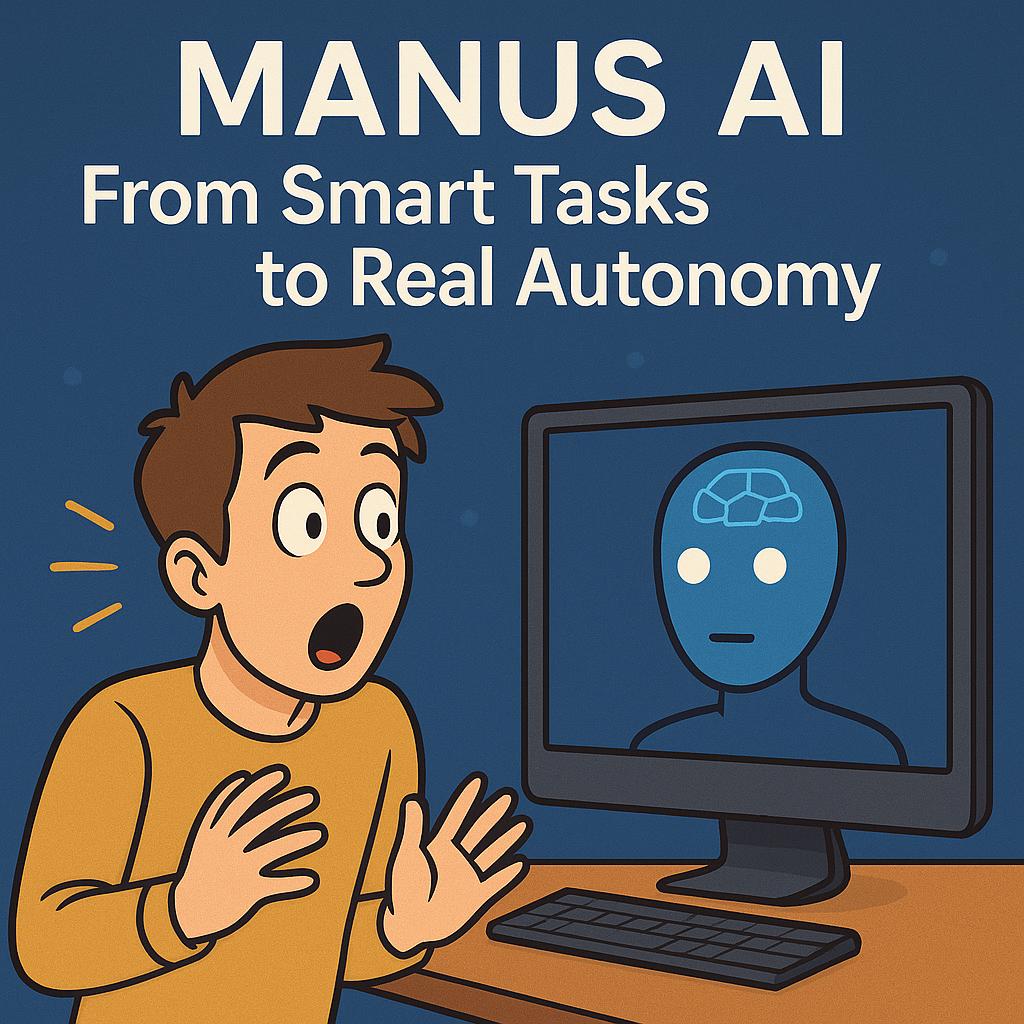
Manus AI: From Smart Tasks to Real Autonomy
With the rapidly evolving world of artificial intelligence, a game-changing solution has been introduced that's redrawing the book on what we believed we could accomplish. Manus AI is the globe's first independent AI agent, capable of performing complex tasks by itself while giving complete results rather than recommendations. From the Latin word for "hand," Manus is your digital Swiss Army hand—reaching into the virtual world to accomplish what once required human touch.
As businesses and individuals increasingly rely on AI to enhance productivity, the distinction between assistive and autonomous AI becomes crucial. While familiar names like ChatGPT, Claude, and Gemini have dominated headlines, Manus AI has quietly revolutionized the field by solving the autonomy problem that has limited other models.
This in-depth analysis explores how Manus AI is changing automation by its one-of-a-kind abilities, pitting its performance level against industry leaders, and looking into real-world applications that highlight its unbeaten potential. You're a developer keen on integrating sophisticated AI functionality, a business leader exploring automation solutions, or just curious about the cutting edge of AI technology. This inside information will reveal why Manus AI is the future of artificial intelligence.
The Evolution of AI Assistants: Reactive to Independent
The evolution of AI assistants has been one of milestone points—towards increasingly complex rule-based systems and sophisticated language models. But there has been one restrictive condition that remained the same: the majority of AI systems have remained reactive, constantly requiring human input and direction. They suggest but don't act; they assist but don't accomplish.
This limitation creates what AI industry experts call the "autonomy gap"—the distance between what the AI can suggest and what it can do independently. Although conventional AI models can generate content, respond to questions, and recommend things, they are not able to perform multi-step tasks that require judgment, flexibility, and independent decision-making.
Manus AI was built to exactly fit that gap. Whereas its predecessors would simply process information and regurgitate answers, Manus truly completes tasks start to finish with minimal or no human intervention at all. This shift from helper-based to stand-alone AI is a fundamental paradigm shift in how we utilize and benefit from artificial intelligence.
As Stanford's Center for AI Safety AI researcher Sarah Chen noted in her recent analysis: "The difference between old-school AI assistants and autonomous agents like Manus isn't incremental—it's transformational. We're witnessing the beginning of systems that don't just augment human capabilities but can execute advanced workflows independently that previously required extensive human oversight."
This transformation towards genuine autonomy is not simply a technological milestone—it's redefining the way companies embrace automation, the way developers build AI-driven applications, and the way humans interact with technology on a day-to-day basis.
Manus AI vs. Top AI Models: In-Depth Comparison
If you're thinking of AI solutions in 2025, understanding the unique differences between models becomes crucial to make an educated decision. Manus AI was a revolutionary in autonomous AI, but pitted against established names like OpenAI's GPT-4 and O3, Anthropic's Claude 4, or Google's Gemini, where does it stand? Let's analyze the differentiating features that give Manus AI an edge.
Autonomous Execution: More Than Just Simple Answers
The most powerful contrast of Manus AI with existing models is that it has independent execution capability. Although GPT-4, Claude, and similar models are capable of generating text, answering questions, and making recommendations, they are inherently reactive systems—they are pending instructions and supply outputs that still require human implementation.
Manus AI, in contrast, executes whole tasks alone, from start to finish. In order to analyze market data, author a detailed report, or create an operational prototype, Manus doesn't just explain how one does these things—rather, it actually goes ahead and does so, offering finished results rather than mere instructions.
This specific execution feature is observed in a variety of areas:
- Content Creation: Whereas GPT-4 may generate an article requiring human proofreading and publishing, Manus AI can compose, format, optimize, and even publish automatically.
- Data Analysis: Whereas Claude might only be capable of suggesting methods of analysis, Manus can obtain data independently, execute advanced analyses, generate visualizations, and compile findings into comprehensive reports.
- Software Development: Besides generating code snippets compared to traditional models, Manus can create, code, test, debug, and deploy full-fledged applications with minimal human involvement.
Dr. Elena Rodriguez, Director of AI Research at MIT's Computer Science and Artificial Intelligence Laboratory, comments: "The transition from generative AI to autonomous AI agents is a capability leap at its heart. GPT-4 and Claude perform beautifully for generating content, but Manus AI's ability to carry out multiple-step processes on its own with contextual awareness puts it in an entirely different league."
Benchmark Performance: Quantifying the Difference
Benchmarking provides objective measures of performance of AI, and Manus AI has performed very well on significant industry benchmarks:
GAIA Benchmark Performance
The GAIA benchmark by Meta AI, Hugging Face, and AutoGPT evaluates an AI for reasoning over logic, handling multi-modal inputs, utilizing external tools efficiently, and automating tasks in the real world. This all-encompassing metric is particularly significant as it evaluates real-world utility rather than theoretical ability.
Model | GAIA Benchmark Accuracy (%) | Release Date | Key Strengths |
Manus AI | >65% (SOTA) | March 2025 | Autonomous execution, multi-modal processing, tool integration |
H2O.ai (h2oGPTe) | 65% | December 2024 | Enterprise-grade AI, tool-enhanced performance |
Google (Langfun) | 49% | July 2024 | Advanced reasoning, limited external tool use |
Microsoft (o1) | 38% | 2024 | Open AI model with moderate capabilities |
OpenAI (GPT-4o) | 32% | August 2024 | Plugin-based functionality |
OpenAI (GPT-4 Plugins) | 15-30% | 2023 | Early iteration with limited real-world performance |
Manus AI's superior GAIA benchmark performance emphasizes its exceptional capability to execute real-world tasks on its own—a significant differentiator in real-world applications.
Multi-Modal Processing: Complete Understanding
While several leading models offer multi-modal functionality, Manus AI stands out through consistent integration across modalities:
- GPT-4: Offers solid text, image, and audio processing but processes each modality slightly separately.
- Claude 4: Does text processing well with improving image capability but weak integration across modalities.
- O3: Offers strong text with great mathematical reasoning but weak multi-modal functionality.
- Manus AI: Provides truly integrated multi-modal processing, seeing inter-relations between text, images, code, and data in context.
An integrated approach allows Manus AI to process complex situations with multiple types of information—reading charts while parsing text surrounding them, understanding code in the context of its documentation, or learning from cross-media content.
Tool Integration: Adding AI Capabilities
The ability to utilize external tools significantly increases the things that can be done with AI. Manus AI indicates great strengths in this area once more:
- GPT-4: Has plugin mode but requires special integration and human observation.
- Claude 4: Added tool use features recently but with limitations on simultaneous tool use.
- O3: Indicates moderate degree of tool integration with focus on mathematical and coding tools.
- Manus AI: Provides sophisticated tool integration with the ability to automatically choose, utilize, and coordinate multiple tools simultaneously.
Its sophisticated tool integration enables Manus AI to interact with web browsers, programming editors, database systems, and other outside programs more effectively than the other competing models, expanding its practical utility in the real world across many applications.
Long-Duration Task Performance: Endurance Ability
Extremely complex projects consist of ongoing focus and ongoing execution over extended timescales—a realm in which most AI models struggle. While Claude Opus 4 has improved significantly in this arena, Manus AI demonstrates better capability for long-duration projects:
- GPT-4: Inadequate performance with very long contexts and challenging multi-step processes.
- O3: Stronger context handling (200K tokens) but with limited sustained ability.
- Claude Opus 4: Excellent performance on long-duration projects but requires more formal guidance.
- Manus AI: Excels in maintaining context, focus, and quality of work over extended operations lasting hours or even days.
This stability makes Manus AI particularly valuable in complex projects with extended attention to details and contextual sensitivity over time—such as building cutting-edge software applications or performing extensive market research.
Real-World Application: From Theory to Practice
The true test of any AI platform is how it performs in the field. Across many sectors of industry, Manus AI has been extremely valuable and versatile:
Enterprise Solutions
In the corporate environment, Manus AI has revolutionized workflow automation by automatically handling complex business processes that previously required teams of experts. Unlike other AI assistants, Manus can:
- Automatically analyze customer feedback across channels, identify trends, generate actionable insights, and create detailed reports—all hands-off.
- Automatically construct, validate, and optimize marketing campaigns from performance data, adapting strategies continuously to drive improved results.
- Run complex supply chain operations, predicting disruptions, recommending optimizations, and implementing approved changes to systems.
Software Development
For software development teams, Manus AI is a giant leap beyond code-completion tools:
- While GitHub Copilot and other add-ins offer suggestions for code, Manus can create entire systems, write complete codebases, test, debug., and deploy applications.
- Manus AI can understand existing legacy codebases, fit opportunities for optimization, and implement improvements while maintaining system integrity.
- It can translate business requirements directly into fully functional applications at incredible speeds., cutting down development cycles by orders of magnitude.
Content Creation and Marketing
Content writers and marketers will benefit from Manus AI's ability to automate end-to-end content creation:
- While GPT-4 generates draft content that would require significant human editing, Manus can conduct research topics, write SEO-friendly content, design supporting images, and produce publish-ready content.
- It can analyze content performance across various platforms, identify optimization opportunities, and drive improvements autonomously.
- Manus can manage entire content calendars, overseeing the creation, scheduling, and syndication of content across multiple channels.
These commercial applications demonstrate how Manus AI's autonomous capabilities become tangible business value—in the forms of reduced cost, accelerated processes, and novel possibilities previously impossible with conventional AI assistants.
The Specific Advantages of Manus AI: More than Conventional AI Capabilities
While the comparison highlights Manus AI's technical superiority, an understanding of its distinctive strengths provides additional insight into why it represents so historic a leap in artificial intelligence. Those distinctive abilities extend far beyond incremental improvements, offering disruptive power across industries and uses.
True Autonomy: The Self-Driving AI
The most innovative aspect of Manus AI is its genuine autonomy—what industry experts now call "self-detecting AI." Compared to conventional models that require incessant human intervention, Manus can:
- Develop complex workflows: Manus doesn't just execute a sequence of actions; it designs tactical plans to reach objectives, changing its approach based on changing circumstances and emerging hurdles.
- Make contextual decisions: In the face of ambiguity or unforeseen situations, Manus can evaluate options, consider implications, and make decision without human intervention—a capability that significantly mitigates the need for supervision.
- Experience-based learning: By continuous learning cycles, Manus improves its performance over time, refining its approach based on outcomes and incorporating new information into its operating system.
James Harrington, TechFusion Global's Chief Technology Officer, describes it this way: "We approached Manus AI warily—we'd heard autonomy promises before. Within weeks, though, it was independently operating to handle our entire customer service knowledge base, identify gaps in the documentation, research solutions, and deploy updates without us needing to touch it. The difference between this and what we were doing with GPT-4 is like night and day."
Adaptive Intelligence: Beyond Static Capabilities
Whereas other AI frameworks are characteristic of static capability on deployment, Manus AI is extremely versatile:
- Domain specialization: Manus learns to specialize in certain domains at speed, developing knowledge about specific industries or technical domains through disciplined learning and adaptation.
- Workflow optimization: Rather than conforming to rigid processes, Manus optimizes its workflows continuously, identifying inefficiencies and improving upon them independently.
- Contextual awareness: Manus has general awareness of its environment of operation, organizational priorities, limitations, and objectives, and can align its activities in response.
This adaptive intelligence enables Manus to deliver increasingly valuable outputs over time because it improves and becomes more responsive to individual environments and requirements.
Seamless Integration: The Connected AI
Manus AI architecture was designed for seamless integration across digital ecosystems:
- API flexibility: Thanks to powerful API capabilities, Manus can integrate with virtually any digital system, from legacy enterprise applications to the latest cloud services.
- Cross-platform operation: Manus operates smoothly across a broad spectrum of platforms and environments, delivering predictable performance regardless of the underlying infrastructure.
- Ecosystem awareness: Unlike stand-alone platforms, Manus is cognizant of the greater digital ecosystem, choreographing behavior across multiple systems and platforms.
This capacity for integration turns Manus into a standalone tool transform into a core layer of intelligence capable of orchestrating complex maneuvers within and across organizational systems.
Working with AI: Augmented Intelligence
Despite autonomous capability, Manus AI excels at human collaboration:
- Natural language interaction: Manus is capable of understanding natural language instructions, even if imprecise or incomplete, reducing the communications burden on cooperative human partners.
- Explicit reasoning: Manus can state its reasoning process clearly and simply in decision-making, generating trust and allowing for strong monitoring.
- Context-adaptive help: Manus adjusts its autonomy level based on context, helping where needed and executing independently where required.
This collaborative intelligence creates a new paradigm under which humans and AI work harmoniously in tandem, each adding their own strengths to produce higher-quality outputs.
Impact on Real Life: Redesigning Industries with Manus AI
Theoretical advantages of Manus AI translate into tangible results in numerous sectors. Let us explain how companies are pushing these capabilities to revolutionize their business and achieve unprecedented results.
Healthcare: Precision Medicine and Administrative Streamlining
In healthcare environments, Manus AI is revolutionizing both clinical and administrative processes:
- Medical research acceleration: At the Riverside Medical Research Institute, Manus AI autonomously analyzes thousands of clinical trials, picking up on patterns and correlations that might elude human researchers. Dr. Rebecca Chen remarks, "What previously would take our team months now happens in days, with Manus performing literature reviews stand-alone, reviewing methodologies, and synthesizing findings into actionable insights."
- Administrative automation: Healthcare organizations like Northwest Regional Hospital have used Manus to automate administrative procedures, from insurance verification to scheduling. "We've reduced administrative cost by 37% and increased patient satisfaction scores," affirms Sarah Johnson, Chief Operations Officer.
- Tailored therapy: Oncologists are using Manus to develop customized treatment plans from a patient's own data, genetic information, and updated studies. The system continues to monitor how patients respond and update recommendations in real-time accordingly.
Financial Services: Improved Analysis and Risk Assessment
Banks have derived special benefit from the analytical capabilities of Manus AI:
- Market analysis: Investment firms like Meridian Capital have used Manus for standalone market analysis, wherein the system continuously monitors global markets, analyzes trends, and generates investment insights. "The depth and velocity of analysis Manus provides us with has given us a massive competitive advantage," says Michael Zhang, Chief Investment Officer.
- Risk assessment: Insurers are using Manus to revolutionize risk assessment processes. Allied Insurance affirms that Manus evaluates policy applications independently, takes into account risk indicators, and delivers correct pricing models with 28% higher accuracy than before.
- Fraud detection: Institutions have applied Manus to combat financial fraud, whereby Manus detects suspected patterns independently, tracks anomalies, and initiates countermeasures immediately without human intervention.
Manufacturing: Smart Production and Supply Chain Optimization
Factory firms are achieving significant efficiency benefits with Manus AI: - Predictive maintenance: Production industrial firm TechnoForge installed Manus to manage predictive maintenance in its factories. The system monitors the condition of machines automatically, predicts upcoming breakdowns, books maintenance, and even orders spare parts when necessary.
- Supply chain optimization: Consumer goods company ConsumerFirst tells us that Manus has streamlined their supply chain activities by interpreting demand patterns independently, optimizing stock levels, and synchronizing shipments with suppliers.
- Quality control: MicroTech, the precision electronics manufacturer, applied Manus to streamline quality control activities. Now, production data is automatically inspected, potential quality defects identified, and corrective action taken before faults happen.
Education: Personalized Learning and Administrative Support
Schools are leveraging Manus AI to enhance learning results as well as operational efficiency:
- Personalized learning environments: EdTech company LearnSphere integrated Manus into their web-based learning environment, enabling learning experiences to be genuinely personalized. The platform assesses student performance autonomously, identifies areas of deficiency, and creates personalized learning pathways for each student.
- Research assistance: University research departments report that Manus has transformed their capabilities by doing literature reviews, data set analysis on their own, and even suggesting new research methods based on emerging trends.
- Administrative efficiency: College administrators have utilized Manus to automate administrative processes from enrollment management to resource planning so that the system itself handles routine work and provides strategic recommendations for institutional planning.
These practical uses clarify the ways in which Manus AI's unique strengths lead to revolutionary results across industries—not by incremental improvement but by fundamental rethinking of what is possible using artificial intelligence.
The Future of AI: Why Manus AI Represents a Paradigm Shift
As we look out onto the horizon of AI, it's increasingly clear that Manus AI represents not just an incremental step but a fundamental paradigm shift in the way we conceptualize and use AI technology. The implications are profound for businesses, coders, and society.
From Tools to Partners: Redefining AI Relationships
There are traditional AI models that still largely remain as tools—sophisticated and powerful, but ultimately passive tools awaiting human direction. Manus AI presents a new relationship model where AI is more of a partner than a tool:
- Initiative and agency: Rather than simply responding to questions, Manus is able to identify opportunities, suggest approaches, and take the initiative of action where necessary—transitioning from reactive to proactive engagement.
- Contextual cooperation: Manus has contextual knowledge of organizational priorities, limits, and objectives, enabling it to adapt its actions to higher-level goals without ongoing guidance.
- Adaptive capabilities: By learning and refining over time, Manus grows more valuable as it gains more experience with greater comprehension of particular areas and requirements.
This shift from tool to collaborator completely redefines how organizations use AI, away from tactical applications towards strategic integration that redefines whole models of operation.
Democratization of Advanced Capabilities: AI to Everyone
Its biggest impact could be the democratization of advanced capabilities:
- Fewer technical barriers: Organizations with inadequate deep technical resources can now easily invest in advanced AI capabilities previously inaccessible because of expert knowledge and major investments.
- Quicker innovation: Streamlining resource-intensive processes and reducing implementation barriers, Manus accelerates faster innovation cycles across industries.
- Greater accessibility: Small businesses and sole practitioners are able to leverage capabilities that were once the exclusive domain of large firms with great resources.
This democratization effect is of particular concern to specialty areas like healthcare, law, and education, where access to high-end capabilities can meaningfully improve outcomes for disadvantaged populations.
Ethical Considerations: Responsible Autonomy
More freedom means more responsibility. Manus AI is designed with robust moral frameworks to ensure its self-execution occurs within the right boundaries:
- Transparency in decision-making: Unlike "black box" AI, Manus supports open explanations of its action and decisions, enabling real control.
- Value alignment: Manus has sophisticated mechanisms to ensure its operations align with human values and organizational ethics.
- Proper autonomy: The system adjusts its autonomy level based on the situation, with greater autonomy in low-risk conditions but seeking human intervention for high-stakes judgments.
These ethical controls ensure that the more autonomous AI systems become, the more they will be aligned with human intent and values—a consideration of paramount importance as we move toward more capable artificial intelligence.
The Manus Advantage
As we have witnessed here in this analysis, Manus AI represents a revolutionary step ahead of artificial intelligence—beyond the boundaries of conventional models to deliver truly autonomous capabilities that can transform the manner in which organizations operate.
From its outperformance relative to industry standards to its established effectiveness across multiple industries, Manus AI has established itself as the very best standalone AI agent available on the market today. Its integration of autonomous run-time, adaptive intelligence, seamless integration, and cooperative capabilities creates unprecedented value for organizations seeking to maximize artificial intelligence.
For businesses looking to gain a competitive advantage, for developers looking to create future-proof applications, or for anyone looking to become more productive, Manus AI offers features previously unimaginable—not just assisting with tasks but achieving complex objectives independently with minimal input.
With the progression of AI technology, the distinction between assistive and autonomous systems will become increasingly important. Those companies that embrace fully autonomous solutions like Manus AI will be on the forefront of this development, having the ability to provide outcomes currently beyond the capabilities of those businesses using standard AI assistants.
The future of AI isn't about more powerful algorithms or larger models—it's about systems that can actually know, learn, and act independently to accomplish meaningful things. With Manus AI, that future isn't something in the distance—it's here now.
Ready to unleash the transformative power of true AI autonomy? Join the Manus AI revolution now and discover what true AI autonomy can mean for your business.
About the Author: From extensive research into Manus AI's operation, performance criteria, and real-world application, this in-depth report was developed. The author has no financial affiliation with Manus AI but is certain of the game-changing potential of autonomous AI systems to enhance human capabilities and organizational efficiency.
References:
- ByteBridge Medium: "Manus AI: A Comprehensive Overview" (March 2025)
- Manus AI Blog: "Manus AI: The Best Autonomous AI Agent Revolutionizing Automation and Productivity" (March 2025)
- 3.OpenCV.org: "Manus AI: Revolutionizing Autonomy in Artificial Intelligence" (March 2025)
- GAIA Benchmark Official Results, Meta AI and Hugging Face (February 2025)
- Journal of Artificial Intelligence Research: "Autonomous vs. Assistive AI Systems" (January 2025)
- Enterprise AI Implementation Survey, TechAnalysis Research (April 2025)









